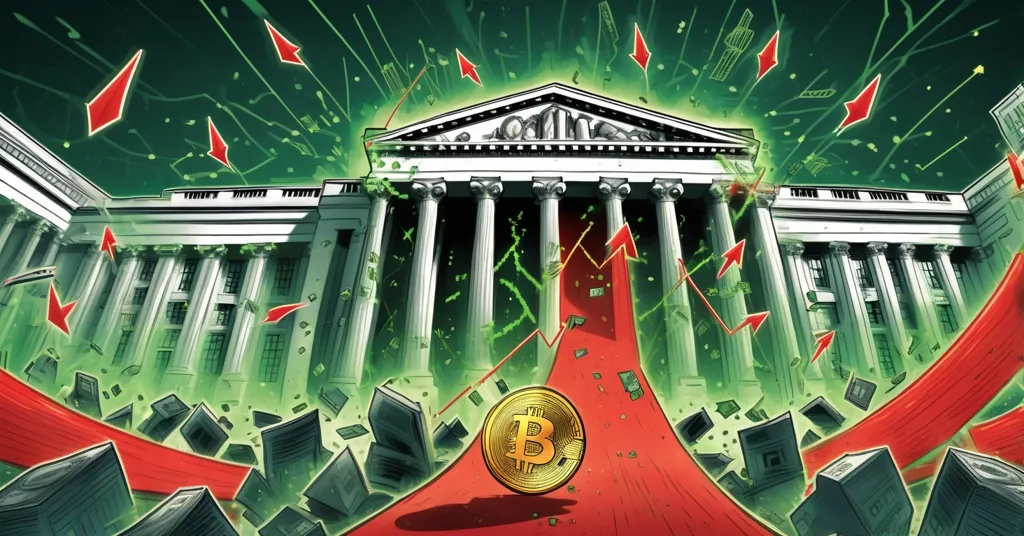US Treasury’s Bitcoin Reserve Misstep Triggers $55B Crash and Altcoin Surge

US Treasury’s Bitcoin Reserve Drama: $55B Market Crash and Altcoin Surge
A single misstep from US Treasury Secretary Scott Bessent sent Bitcoin into a tailspin, wiping out $55 billion in market cap in under an hour, only for a swift clarification to pull it back from the brink. This chaotic episode, paired with a wave of speculative altcoin buzz, lays bare the raw power of government words in crypto and the wild opportunism that follows.
- Market Shock: Bessent’s initial remark against buying Bitcoin for the US reserve triggered a price drop from $124,000 to $117,000, erasing $55 billion in 40 minutes.
- Damage Control: A follow-up post on X reaffirmed commitment to expanding the reserve, stabilizing Bitcoin at $119,000.
- Altcoin Buzz: Projects like Maxi Doge ($MAXI), Chintai ($CHEX), and Bitcoin Hyper ($HYPER) emerge as speculative plays amid renewed confidence.
Treasury’s Blunder and Bitcoin’s Fallout
Bitcoin was riding high at a record-breaking $124,000 when Treasury Secretary Scott Bessent appeared on Fox Business and dropped a grenade. His statement was blunt:
“We’ve also started to get into the 21st century, a Bitcoin reserve. We’re not going to be buying that, but we are going to use confiscated assets and continue to build that up.”
The market didn’t pause for nuance. In just 40 minutes, Bitcoin’s price cratered to $117,000, slashing $55 billion from its market cap as investors scrambled to sell. For a currency often hailed as immune to government meddling, this was a stark wake-up call. Why such a drastic reaction? Crypto markets, especially Bitcoin, are hypersensitive to institutional signals. When a figure like Bessent hints at reduced demand from a major player like the US government, panic spreads faster than a meme coin pump. For those new to the space, understand this: Bitcoin’s price isn’t just about code or miners—it’s about perception, and government whispers can scream louder than any technical analysis. Learn more about the initial market shock triggered by Bessent’s comments here.
Recovery and Reserve Realities
The freefall didn’t last. Within hours, Bessent took to X to clean up the mess with a clearer message:
“Treasury is committed to exploring budget-neutral pathways to acquire more Bitcoin to expand the reserve.”
Translation? The US isn’t writing off Bitcoin; they’re just looking for ways to stack more without dipping into taxpayer funds. Think of it as swapping assets—like trading gold bars for digital coins—or even issuing special Bitcoin bonds to fund the reserve without adding to the national debt. This pivot restored confidence, nudging Bitcoin’s price back to $119,000. More crucially, Bessent confirmed the US already holds between $15 billion and $20 billion in Bitcoin, largely from seized criminal assets, with zero plans to sell. Established under a March 2025 executive order, this reserve reflects a bold ambition to position the US as the “Bitcoin superpower of the world,” a phrase Bessent has echoed repeatedly. It’s a far cry from the days when Bitcoin was branded a fringe toy for tech nerds or a haven for illicit deals. For details on the current scale of US Bitcoin holdings and reserve plans, check this out.
Centralization Conundrum
Let’s chew on this US Bitcoin reserve for a moment. Holding $15-20 billion is no small feat—it’s a neon sign that crypto has gone mainstream, validated by the very institutions it was built to defy. This could stabilize markets by signaling long-term confidence, much like gold reserves have historically backed fiat currencies. But here’s the rub: Bitcoin’s soul is decentralization, a rejection of centralized power. Uncle Sam turning into the ultimate HODLer feels like a cosmic irony. What happens if this reserve becomes a political pawn—dumped during a budget crisis or weaponized in trade wars? There’s no formal legislation or detailed playbook for managing these holdings, just vague promises and a pending White House report on digital assets. A cynical take? This could erode trust in Bitcoin more than any exchange hack. If governments start playing whale games, the dream of financial sovereignty gets murkier. On the flip side, this hoard might push other nations to follow suit, cementing Bitcoin’s role as a global reserve asset. It’s a tightrope, and every statement from folks like Bessent is a gust of wind. For a broader perspective on the concept of a strategic Bitcoin reserve, this resource is worth a look.
Bitcoin’s Broader Challenges
Beyond government drama, Bitcoin faces stubborn hurdles that this incident throws into sharp relief. Its network chugs along at a measly 7 transactions per second (TPS), compared to Ethereum’s 15-30 TPS or Solana’s lightning-fast 1,000-plus TPS. Want to buy a coffee with Bitcoin? Good luck—high fees and slow confirmations make it impractical for everyday use. The Total Value Locked (TVL), which measures money tied up in a blockchain’s apps and services, sits at $7.662 billion for Bitcoin, a distant third behind Ethereum’s whopping $94.74 billion. These stats highlight why Bitcoin shines as a store of value—digital gold, if you will—but lags as a functional currency. Bessent’s blunder wasn’t just a price dip; it was a stress test. Can Bitcoin scale for mass adoption while staying true to its anti-establishment roots, even as governments cozy up? That’s the million-dollar question—or, at current prices, the 119,000-dollar one. For an in-depth analysis of government influence on Bitcoin market dynamics, this is a solid read.
Altcoin Frenzy: What’s Hot
As Bitcoin steadied itself, the crypto hype machine revved up, spotlighting smaller projects eager to ride the wave of volatility. While Bitcoin dominates the spotlight, these altcoins pitch themselves as niche innovators—or, let’s be honest, risky gambles. Here’s a rundown of three grabbing attention: Maxi Doge ($MAXI), Chintai ($CHEX), and Bitcoin Hyper ($HYPER). For insights into the recent surge in altcoin interest following Bitcoin reserve news, this update has more.
Maxi Doge ($MAXI): Priced at $0.000252 in presale, this dog-themed meme token has raised nearly $1 million ($980,000 so far). With 40% of tokens earmarked for marketing and 15% for the dev team, it’s banking on viral buzz, promising gamified tournaments and integration with a futures trading platform. Audits by Coinsult and SolidProof found no red flags in its smart contract, but meme coins are the carnival rides of crypto—thrilling until the bolts snap. They thrive on FOMO, not fundamentals, and history shows most fizzle out or worse, rug-pull investors.
Chintai ($CHEX): Trading at $0.1785, up 103% in a week and 35% over the past month, Chintai operates on the EOS blockchain to tokenize real-world assets (RWAs). This means turning physical stuff like real estate or art into digital tokens for fractional ownership, unlocking liquidity in markets usually reserved for the ultra-wealthy. The RWA space is valued at $26 billion on-chain, with over 350,000 holders (up 11% recently) and projections to hit $16 trillion by 2030. Chintai’s regulated platform hints at blockchain’s power to upend traditional finance, though legal battles over ownership and regulatory roadblocks could derail the dream.
Bitcoin Hyper ($HYPER): A Layer 2 network for Bitcoin, priced at $0.012725 in presale with $9.6 million raised, aims for a post-launch value of $0.32—a potential 2,414% spike. Layer 2 solutions are secondary networks built on top of blockchains to boost speed and cut costs while tapping the main chain’s security. Using the Solana Virtual Machine (SVM), Bitcoin Hyper wants to enable smart contracts and DeFi (decentralized finance) on Bitcoin, turning it into an Ethereum-style powerhouse. It’s a seductive vision, but untested—presale hype often outruns reality, and failed scaling projects litter crypto’s graveyard.
Risks and Realities in Speculation
Before you rush to YOLO into these altcoins on the heels of Bitcoin’s recovery, let’s get real. The crypto space is a minefield of empty promises and outright scams, especially with presale tokens. Maxi Doge might mimic Dogecoin’s meme magic, or it could vanish with your funds overnight—there’s little transparency on the team or long-term plans. Chintai’s RWA focus taps a legit trend, but scaling to a $16 trillion market? That’s a fairy tale without ironclad regulation and mass adoption, both distant prospects. Bitcoin Hyper’s DeFi dreams for Bitcoin sound revolutionary, yet execution risks are massive—most Layer 2 hopefuls stumble. Unlike the clickbait price predictions flooding social media (usually just shills in disguise), the goal here isn’t to pump bags but to lay out the raw potential and equally raw pitfalls. If you’re eyeing these, tread with extreme caution. Bitcoin, for all its volatility, offers relative stability as the king of crypto. Altcoins? They’re often a dice roll—don’t stake what you can’t lose. For community discussions on Bessent’s Bitcoin reserve statement, this thread provides varied perspectives.
Bitcoin’s Bigger Picture
Zooming out, Bessent’s flip-flop is a microcosm of Bitcoin’s awkward dance with power. The US Treasury hoarding $15-20 billion and teasing further accumulation marks a seismic shift—governments aren’t just policing crypto, they’re players now. This validates Bitcoin’s staying power but frays its decentralized ethos. Meanwhile, altcoins like Maxi Doge, Chintai, and Bitcoin Hyper highlight the diversity beyond Bitcoin’s shadow, chasing niches from meme mania to real-world disruption and scalability fixes. As a Bitcoin maximalist, I’ll always argue BTC is the gold standard of freedom, the truest shot at financial sovereignty. But I can’t ignore that Ethereum, Solana, and even these speculative upstarts fill gaps Bitcoin doesn’t—and maybe shouldn’t—touch. The path to a decentralized future isn’t a solo mission; it’s a messy relay. Keep an eye on the upcoming White House digital asset report and altcoin launches—they’ll shape whether this saga leans toward liberation or control. For opinions on whether US Treasury actions impact Bitcoin’s future as money, this discussion offers some thought-provoking takes.
Key Takeaways and Questions
- What sparked Bitcoin’s dramatic price crash?
Scott Bessent’s initial statement on Fox Business against buying more Bitcoin for the US reserve ignited panic, causing a $55 billion market cap loss as the price dropped from $124,000 to $117,000 in 40 minutes. - How did Bitcoin bounce back so fast?
Bessent’s clarification on X, pledging to explore budget-neutral ways to grow the reserve, rebuilt trust, stabilizing the price at $119,000. - What’s the US stance on its Bitcoin holdings?
The US holds $15-20 billion in Bitcoin, mostly from seized assets, with no intent to sell and a focus on expanding via methods like asset swaps or Bitcoin bonds. - Does a government Bitcoin reserve clash with decentralization?
Absolutely—it risks centralizing influence in state hands, contradicting Bitcoin’s core anti-establishment vibe, though it also boosts mainstream credibility. - Are altcoins like Maxi Doge, Chintai, and Bitcoin Hyper safe bets?
Hardly. They tap into intriguing trends—memes, asset tokenization, and scaling—but are riddled with risks like scams or unproven tech. Approach with skepticism and spare change only. - Can Bitcoin overcome its technical limits amid institutional play?
It’s tough—slow speeds (7 TPS) and high fees hinder daily use, but Layer 2 solutions and government backing might bridge gaps if they don’t compromise Bitcoin’s ethos.



